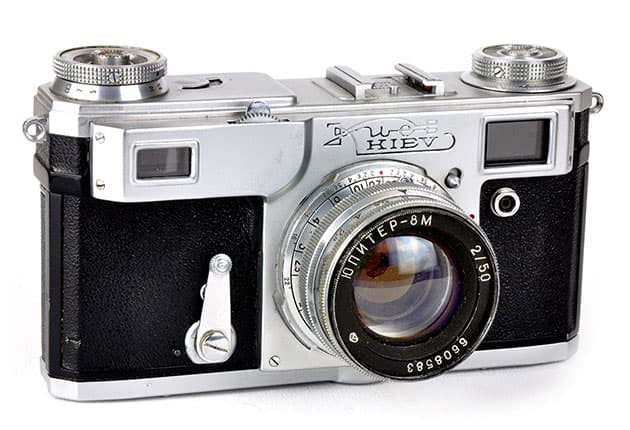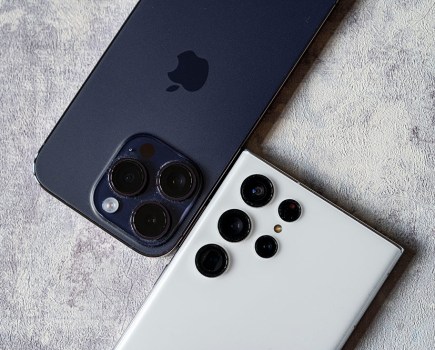Whether you’re new to photography or an old hand, the second-hand film camera market is awash with possibilities, John Wade guides us. First, though, when considering buying a second-hand film camera, it helps to decide what type of film you want to use. There have been many film sizes over the years but two have endured: 35mm and 120 roll film.
If you already own a collection of modern autofocus lenses that you wish to continue using, there are 1990s AF classics like the Canon EOS 3 or Nikon F100 to choose from. If you feel more adventurous, though, go back a few years more.
The film world has seen a vast range of camera styles, from panoramic to stereo, from subminiature to large format. However, for a good usable camera today, restrict yourself to one of six types. For 35mm, look at single lens reflexes (SLRs), rangefinder cameras or simple viewfinder models. For 120 roll film, consider medium format SLRs, twin lens reflexes (TLRs) and perhaps older folding models.
Among all these you’ll find quality cameras that still demand top prices, high-spec cameras available for a fraction of their original cost and inexpensive cameras still capable of delivering excellent results. We consider them all here. To avoid quoting pre-decimal currency, the original prices we give are approximate and rounded up to the nearest pound. Guide prices are based on averages of recent eBay sales. With interchangeable lens cameras, original and current prices may vary according to the lenses supplied with them.
Good quality, decent price
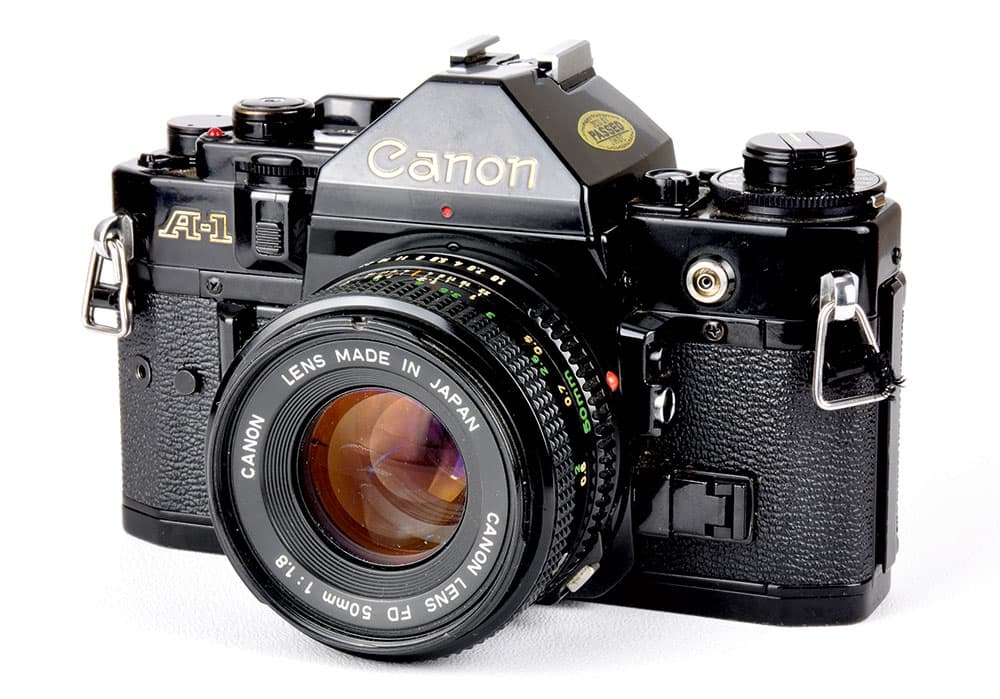
Canon A1, the first SLR with programme automation
Canon A-1
- Type 35mm SLR
- Launched 1978
- Original price £220
- Guide price now £100-140
The flagship model in Canon’s A-series that began with the AE-1 was the first SLR to offer programmed automation, along with four further exposure modes: manual, shutter priority, aperture priority and stopped down AE.
Made only in black, the A-1 accepts Canon’s vast range of bayonet and breech-lock FD lenses, plus the FL lenses that preceded them, albeit with restricted automation. Accessories include the Motordrive A for five frames per second, Databack A and Speedlight 155A. A single PX-28 battery runs all the functions. Meanwhile, shutter speeds and apertures are controlled by a thumbwheel, in conjunction with a mode selection lever. With the lever set to ‘Tv’ shutter speeds are displayed in a window to the side. As it is turned to ‘Av’, the window display changes to apertures. Shutter speeds run from 1/1,000sec down to a full 30 seconds.
WE SAY The A-1 was ahead of its time at its launch. For users today, it is still a well- specified and reliable camera.
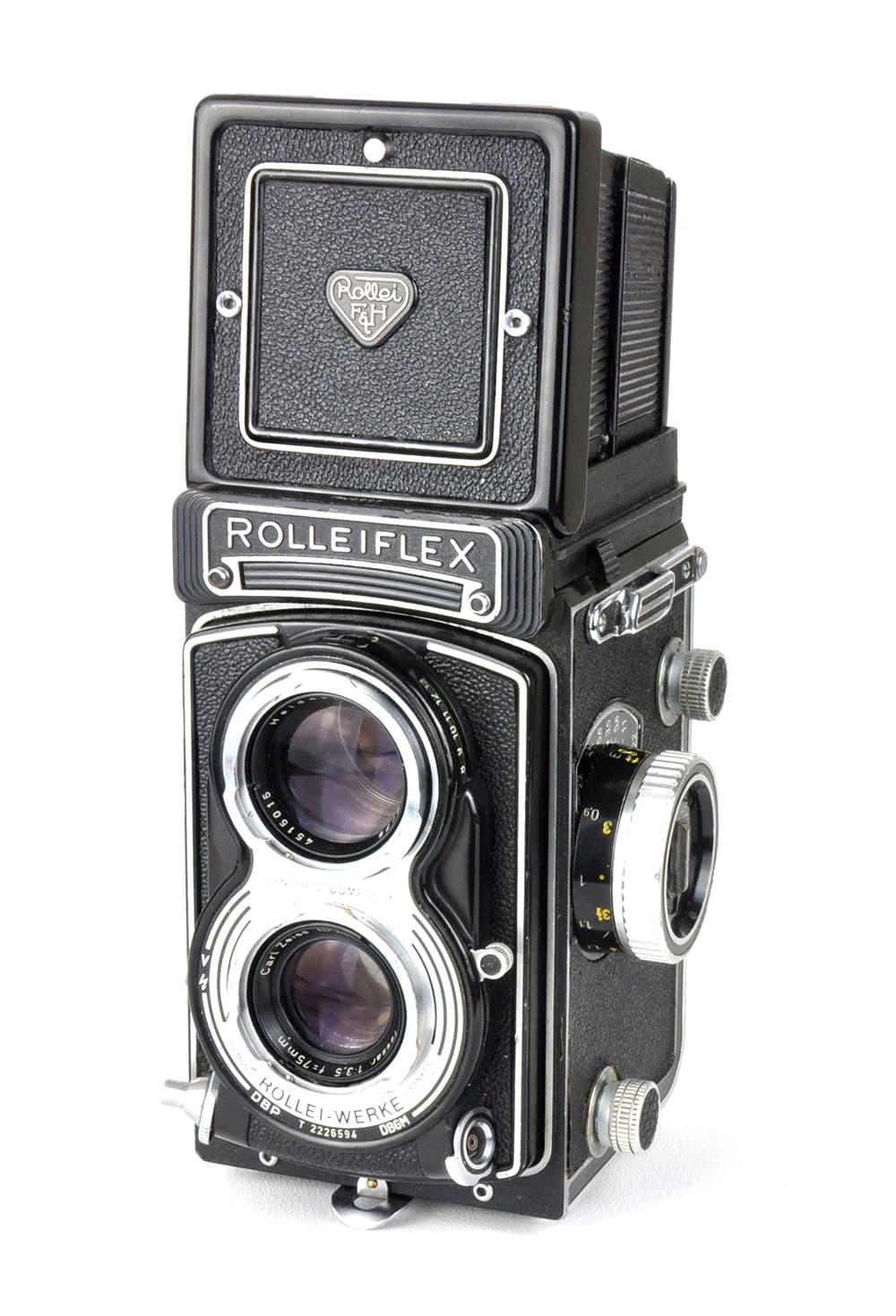
Rolleiflex T was, and still is, a budget Rolleiflex
Rolleiflex T
- Type Medium format TLR
- Launched 1958
- Original price £85
- Guide price now £200-400
Rolleiflex cameras were always known for quality at a high price but the T was introduced at a lower cost to sit between the budget priced Rolleicords and top-of-the-range Rolleiflex 3.5f and 2.8f. Despite its lower price, it sports a well-respected f/3.5 Tessar lens coupled, for focusing, to an f/2.8 Heidosmat that displays its image on a large ground-glass screen on the top of the body. Image size is 6x6cm. Apertures of f/3.5-f/22 are coupled to shutter speeds of 1-1/500sec, set by a single lever to the side of the taking lens.
WE SAY The Rolleiflex T makes a great introduction to medium format TLR photography.
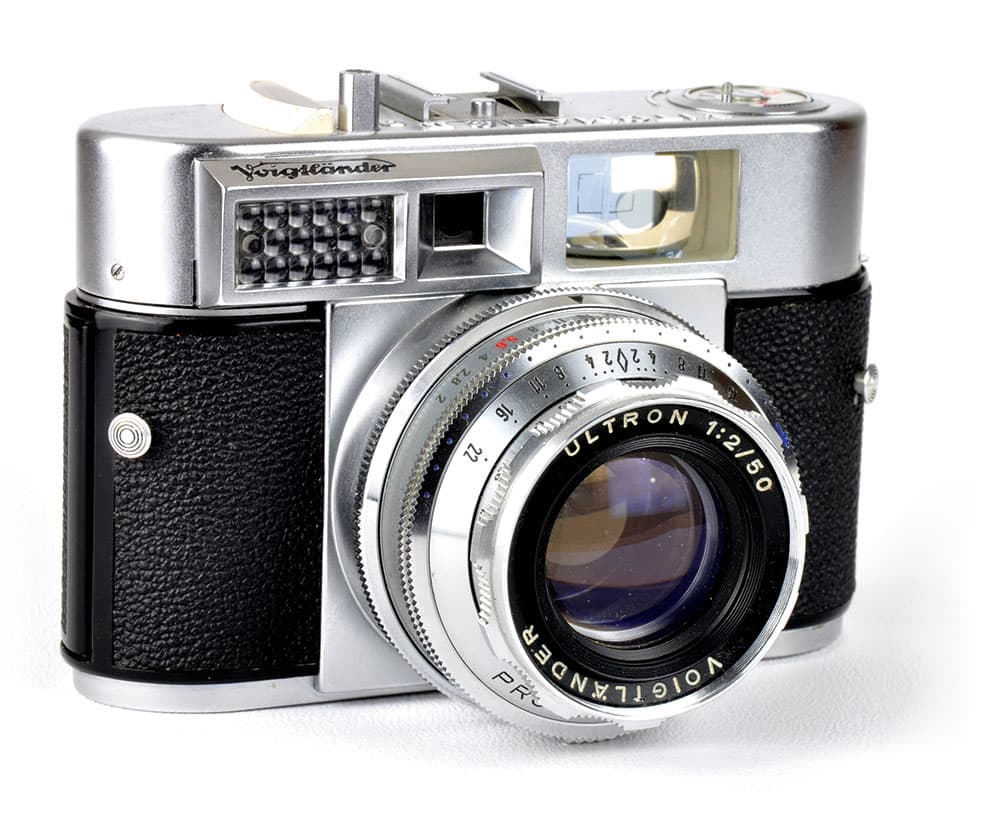
The f/2 Ultron version of the Vitomatic IIa
Voigtländer Vitomatic IIa
- Type 35mm rangefinder camera (Ultron version)
- Launched 1960
- Original price £68
- Guide price now £150-200
The Vitomatic IIa is heavy, solid and beautifully made. The bright viewfinder supports a coincident image rangefinder linked to the focusing. A built-in selenium cell meter is coupled to shutter speeds and apertures to confirm correct exposure as you adjust each to match a needle to a circular icon in the viewfinder.
The shutter won’t fire until the film has been advanced, and there must be a film in the camera to activate the mechanism. The point is, an empty camera will appear to have a jammed shutter.
WE SAY The Vitomatic IIa is inexpensive with an f/3.5 Color Skopar lens; more expensive with the better f/2 Ultron (prices quoted above are for the Ultron version).
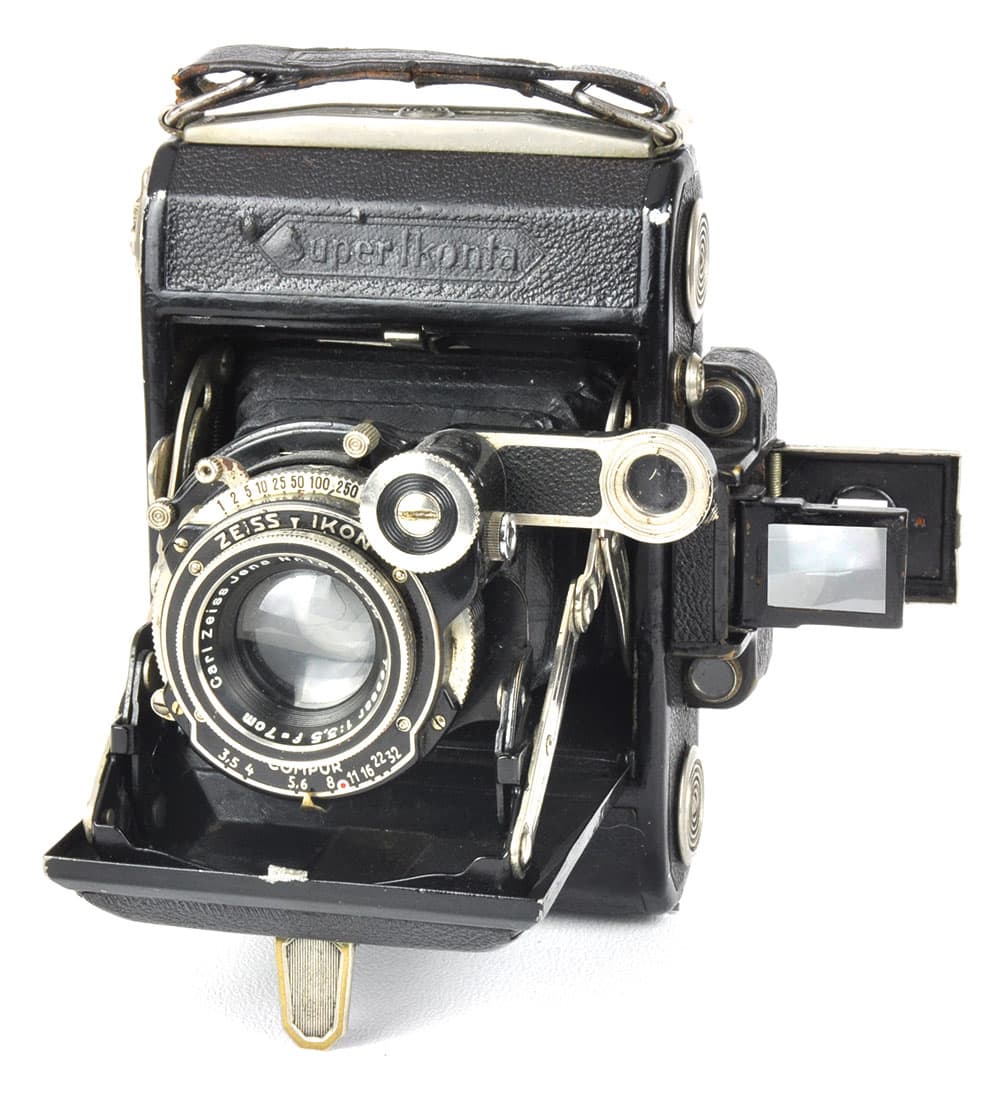
Zeiss Ikon Super Ikonta A
Super Ikonta A
- Type Roll film folding camera
- Launched 1934
- Original price £16
- Guide price now £250-£300
If you’re looking for a different way inot medium format photography, don’t overlook folding cameras of the past. Some are very cheap. This more expensive example, made by Zeiss Ikon, is one of the best. It uses a twin red window system for reading film numbers to shoot 16 6×4.5cm images.
The camera folds to a flat, pocket- size shape, uses an f/3.5 Tessar lens and shutter speeds are 1-1/500sec. Its superior rangefinder is based on technology used by Zeiss in its Contax cameras.
WE SAY Be aware of unbloomed lenses that are prone to flare when shooting against the light, and the possibility of sticky, slow shutter speeds.
High quality, high price
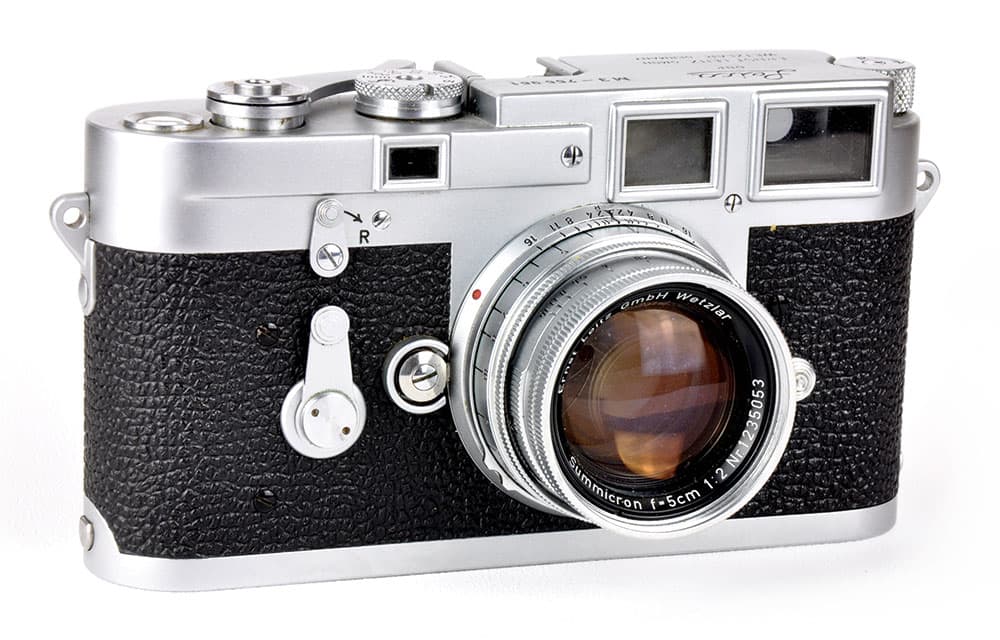
Leica M3, one of the best 35mm rangefinder cameras
Leica M3
- Type 35mm rangefinder camera
- Launched 1954
- Original price £185
- Guide price now £700-900
Sometimes regarded as the best 35mm camera ever made, the M3 was the start of a new body style for Leica, a change from screw-fit to bayonet mount lenses and a longer based, more accurate, rangefinder.
The camera accepts Leica’s vast range of M lenses, with guides in the viewfinder for 50mm, 90mm and 135mm focal lengths, which appear automatically as each lens is fitted. The camera is completely manual but a Leicameter can be added that links to the shutter speed dial, with settings of 1-1/1,000sec. Film wind is by a lever, which takes two strokes on early cameras and a single stroke on later models.
WE SAY The prices are high even today, but pick up an M3 and you might find that you never want to put it down.
Second-hand film cameras continued…
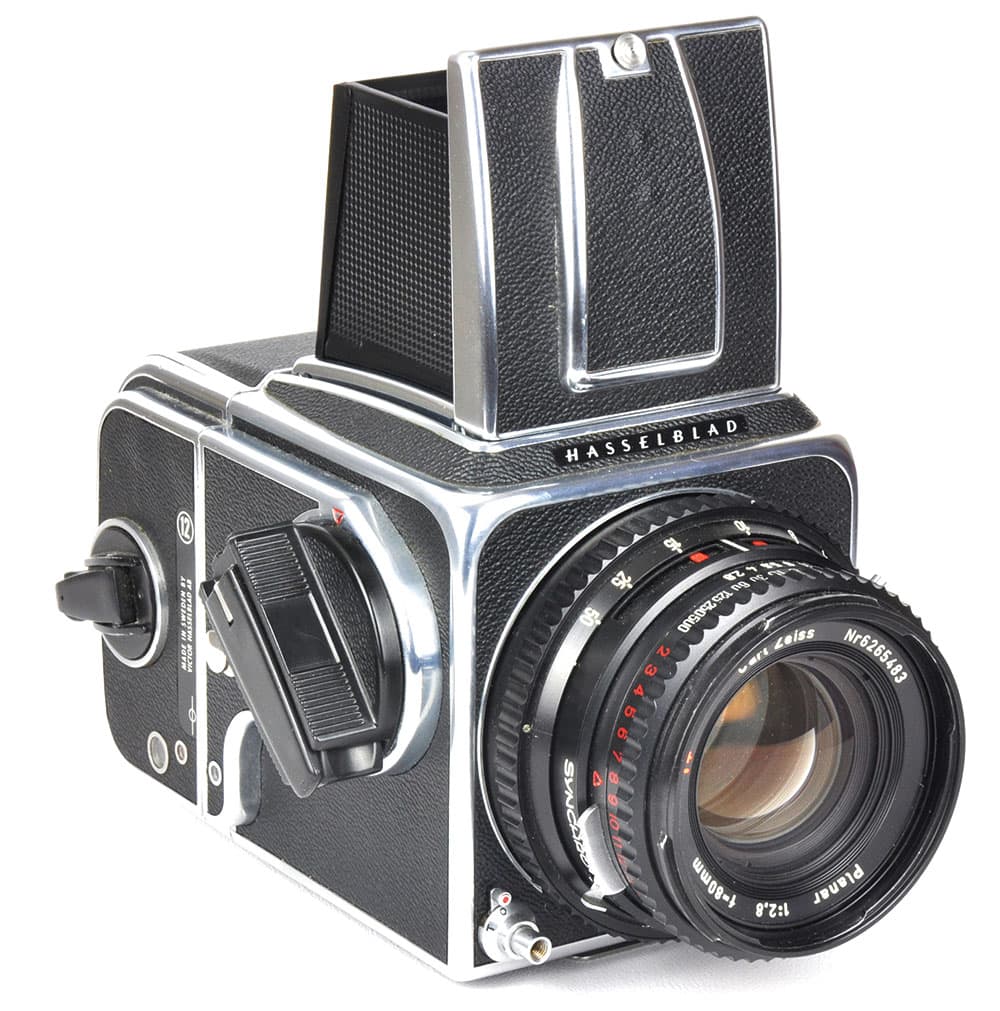
Hasselblad 500CM, a top-quality medium format SLR
Hasselblad 500CM
- Type Medium format SLR
- Launched 1970
- Original Price £300
- Guide Price now £600-800
Hasselblad had been making roll film SLRs for more than 20 years when the CM was launched, and this is one of the best for the newcomer to the company’s cameras.
It breaks down into a modular design of body, lens, film back and viewfinder, with a leaf shutter incorporated into each lens. Interchangeable film backs means you can pre-load and change on the run. It shoots 12 6x6cm images to a roll.
WE SAY Focusing screens can be interchanged and it’s worth seeking out a camera that has had the special bright screen version fitted.
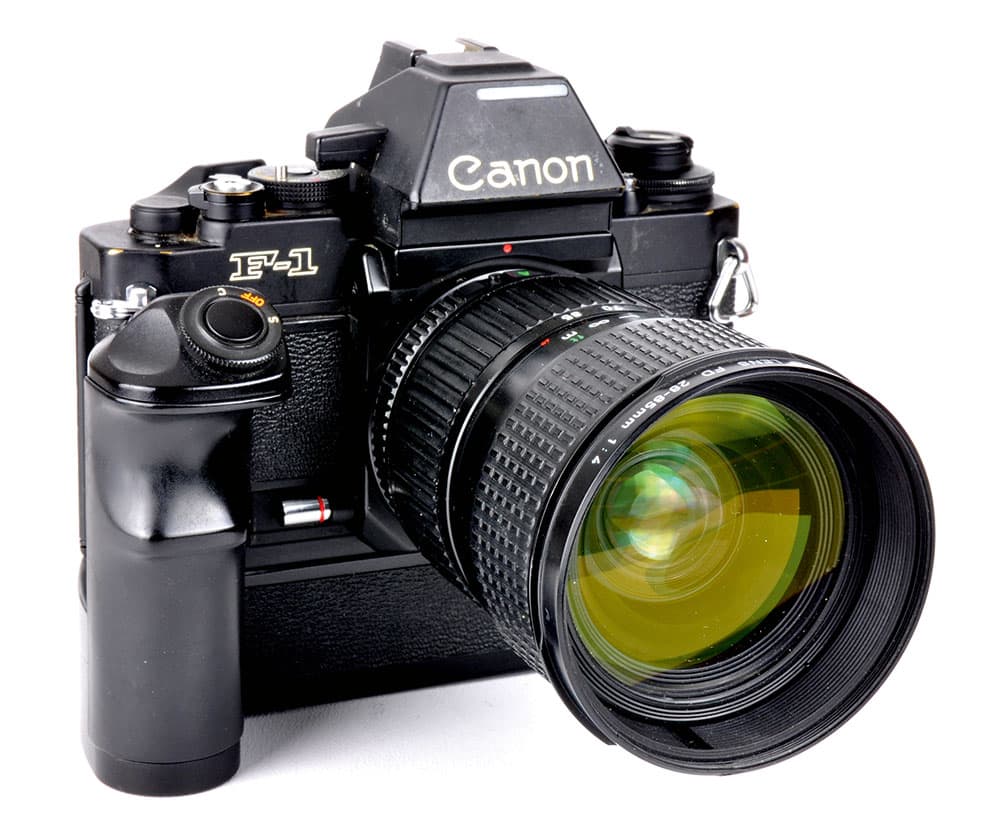
Canon New F-1 with AE finder and 28-85mm macro lens
Canon New F-1
- Type 35mm SLR
- Launched 1981
- Original £400
- Guide price now £200-250
The new F-1 was the third and best variation of this camera, after the F-1 and the F-1n in 1971 and 1976. You can buy one at a reasonable price and then, as your budget dictates, customise it to your own needs. The basic camera is manual with match-needle CdS metering in the viewfinder. Replace the standard viewfinder with the AE version and the camera is converted to aperture priority. Add the AE power winder or motor drive to the base and you get shutter priority automation as well. Add a Canon 28-85mm macro zoom and you have a versatile kit that will cover many needs.
WE SAY Shutter speeds are electronic at 1/60sec and below; mechanical at 1/125sec and above.
Top specs, budget prices
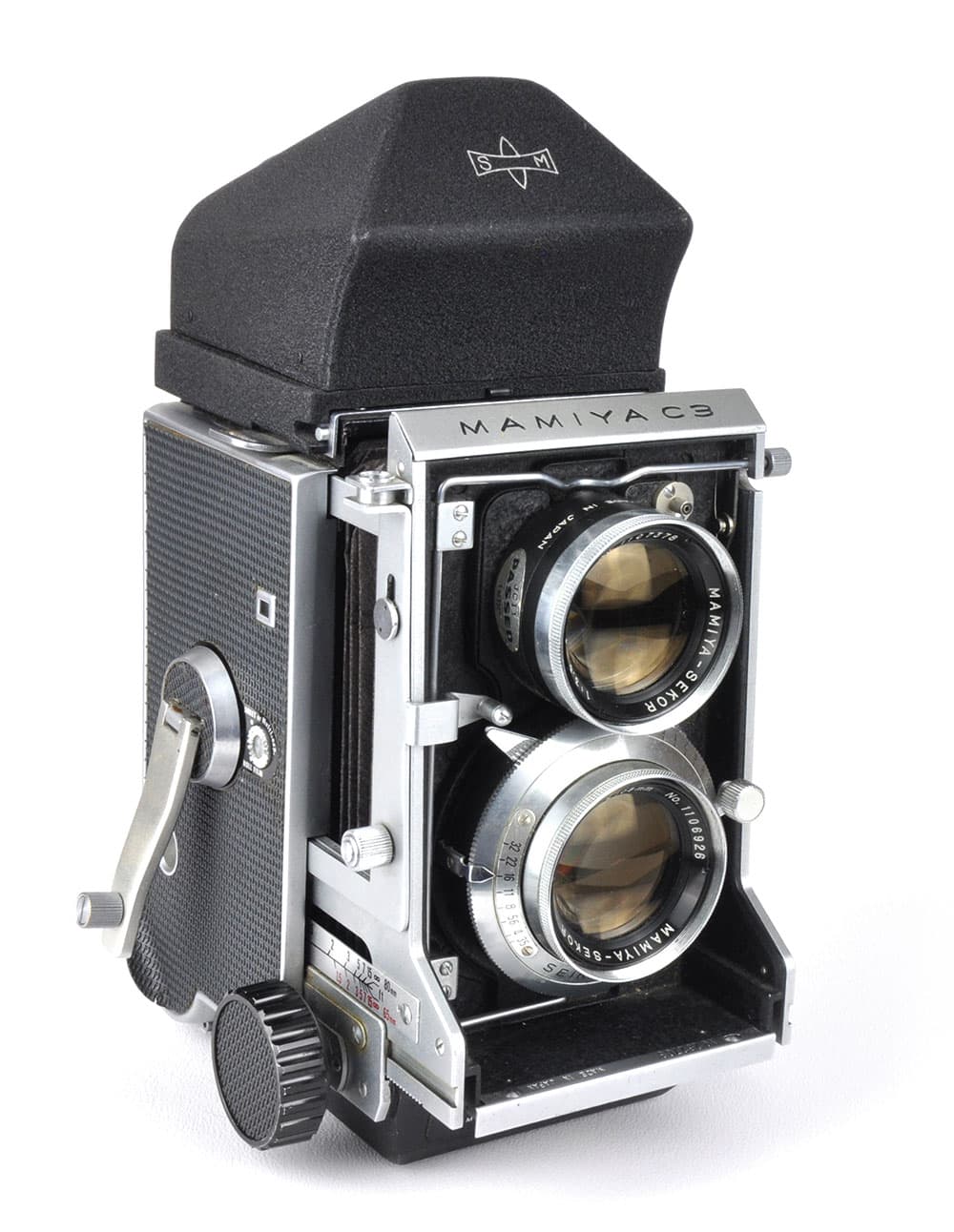
Mamiya C3 with prism finder fitted for eye-level viewing
Mamiya C3
- Type Medium format TLR
- Launched 1962
- Original price £100
- Guide price now £80-120
Along with sister cameras that include the C33, C330, C22 and C220, the Mamiya C3 is unusual in being a TLR that offers interchangeable lenses. The camera bodies are reasonably priced today; however, the extra lenses add expense.
The standard lens is 80mm focal length, but a range from 55mm wide angle to 250mm telephoto is available. Because this is a TLR, the lenses come in pairs for shooting and viewing, and each of the taking lenses incorporates its own shutter. They are focused by twin knobs at the base of the body which move the lenses together backwards and forwards on bellows. The image size is 6x6cm on 120 film.
Made, principally, for a waist-level viewfinder, eye-level prism finders are also available, as well as a range of focusing screens and other accessories.
WE SAY It all adds up to one oft he most versatile TLRs you’re likely to find on the second-hand market.
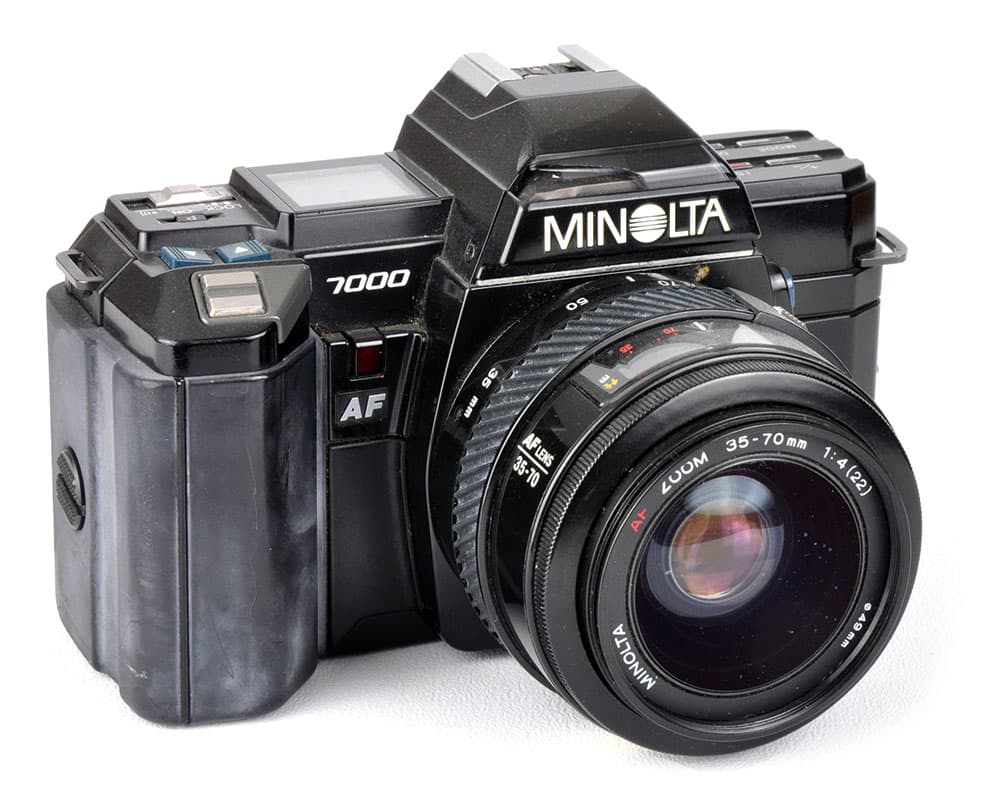
Minolta 7000, the first body-integral autofocus SLR
Minolta 7000
- Type 35mm AF SLR
- Launched 1985
- Original price £330
- Guide price now £20-30
This was the first SLR with body-integral autofocus. It might be slow and somewhat primitive by today’s standards, but it works, it’s reliable and
it can be bought at a reasonable price.
As well as autofocus, which is designed to work well in low light, the camera offers the usual exposure modes, plus wide program and tele program. With these, the camera takes data from the focal length of the lens in use and translates it into information that sets the most appropriate exposure mode.
WE SAY The Minolta 7000 marked the start of a new era in SLR photography, which makes it an interesting as well as a very usable camera.
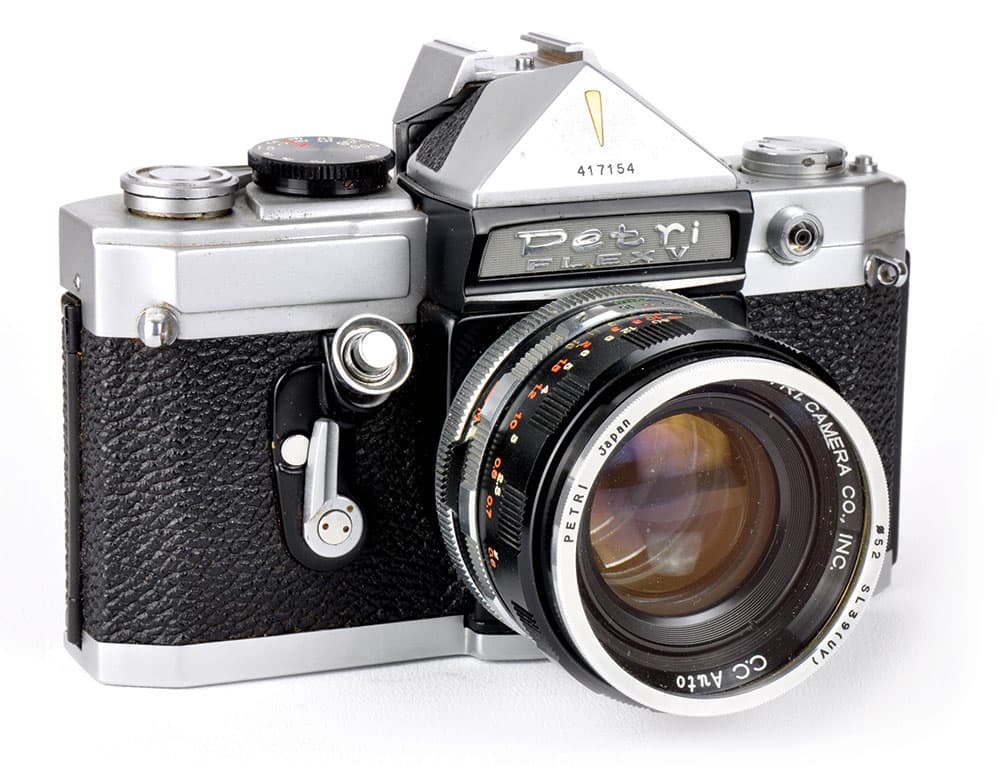
Petri Flex V, a good camera with an uncommon lens mount
Petri Flex V
- Type 35mm SLR
- Launched 1961
- Original price £59
- Guide price now £20-25
As the craze for attaching film camera lenses to mirrorless digital cameras continues, second-hand lenses are becoming more valuable than their camera bodies, forcing up the price of SLRs with lenses.
To combat that problem, move manufacturers for which so many Chinese lens adapters are available, and go for an SLR with a less popular mount.
The Petri Flex takes its own-brand breech- lock bayonet lenses which, being a lot less common than those from Olympus, Canon and Nikon, aren’t so sought after by digital photographers.
WE SAY A good, well-specified 35mm SLR at a cheaper than usual price.
Second-hand film cameras continued…
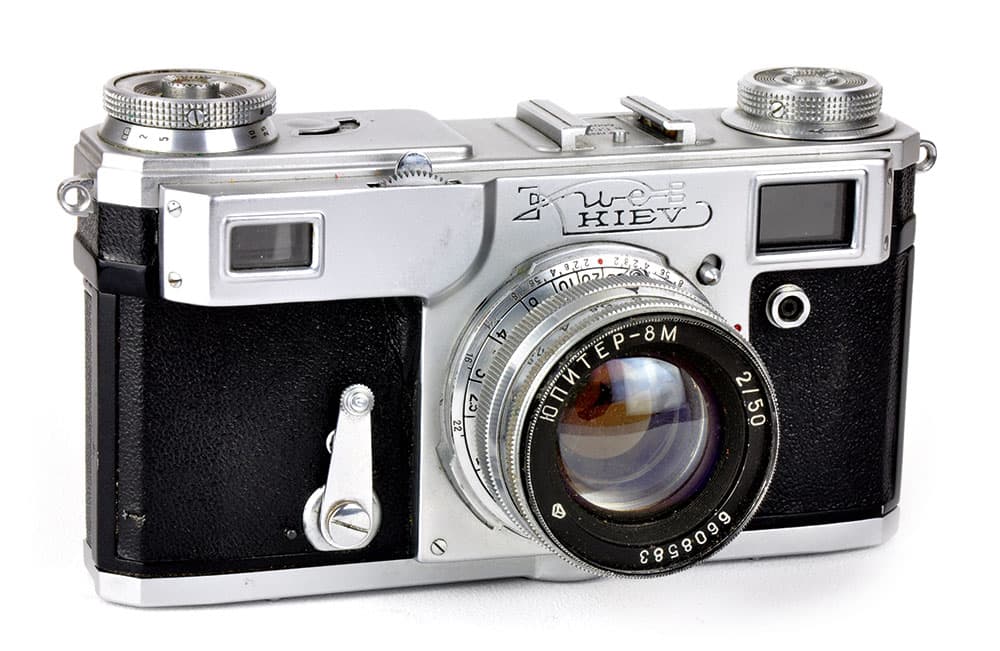
Kiev IIa, a Russian copy of the Contax II
Kiev IIa
- Type 35mm rangefinder camera
- Launched 1955
- Original price £49
- Guide price now £30-35
Back in the 1930s, Contax cameras were revered for their quality, and they are still expensive today. Following the Second World War, the Ukrainian Kiev Arsenal factory obtained materials and tooling owned by the German Zeiss Ikon factory and began manufacturing its own versions of Zeiss cameras. As a result, the Kiev IIa camera is a Contax II in everything but name.
The top shutter speed is 1/1,250sec and Jupiter lenses supplied with Kiev cameras turn out good quality images. Here’s the best bit, though: Kiev and Contax cameras share similar lens mounts, so you can equip a Kiev body with a vast range of top-quality Zeiss lenses, originally made for the Contax.
WE SAY The smart way to own a Contax without paying the Contax premium.
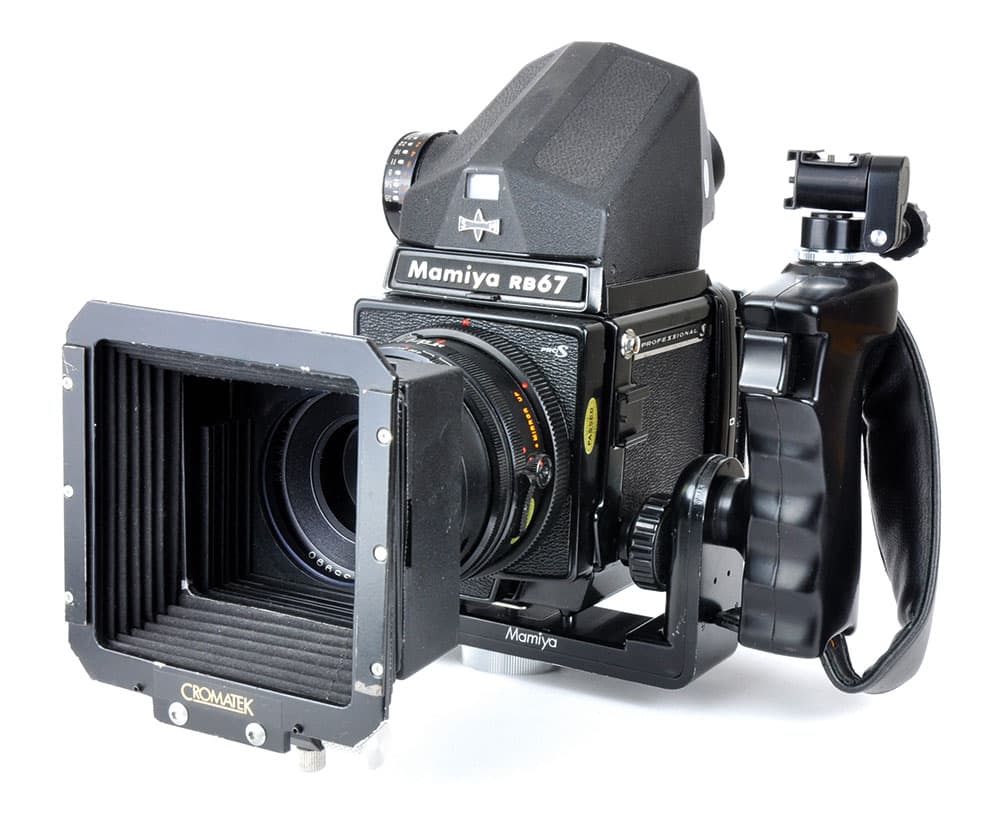
Mamiya RB67 Pro Swith Chromateck lens hood/filter holder
Mamiya RB67 Pro S
- Type Medium format SLR
- Launched 1974
- Original price £750
- Guide price now £250-300
The big selling point of this large camera is its big picture size: 6x7cm, ten exposures on 120 film. The standard lens is a 90mm f/3.8 with built-in Seiko shutter speeded 1-1/400sec, but a lens range from 37mm fisheye to 500mm telephoto is available.
The basic camera with waist-level viewfinder can be bought for a third of its original price, but to that you can add all those extra lenses, focusing screens and various metered or non-metered viewfinders, as well as accessories including speed grips, extension tubes, lens hoods, filters and spare film backs.
WE SAY If you are looking for a solid, well-made camera with a larger than average medium format image, you can’t do better than the RB67 Pro S.
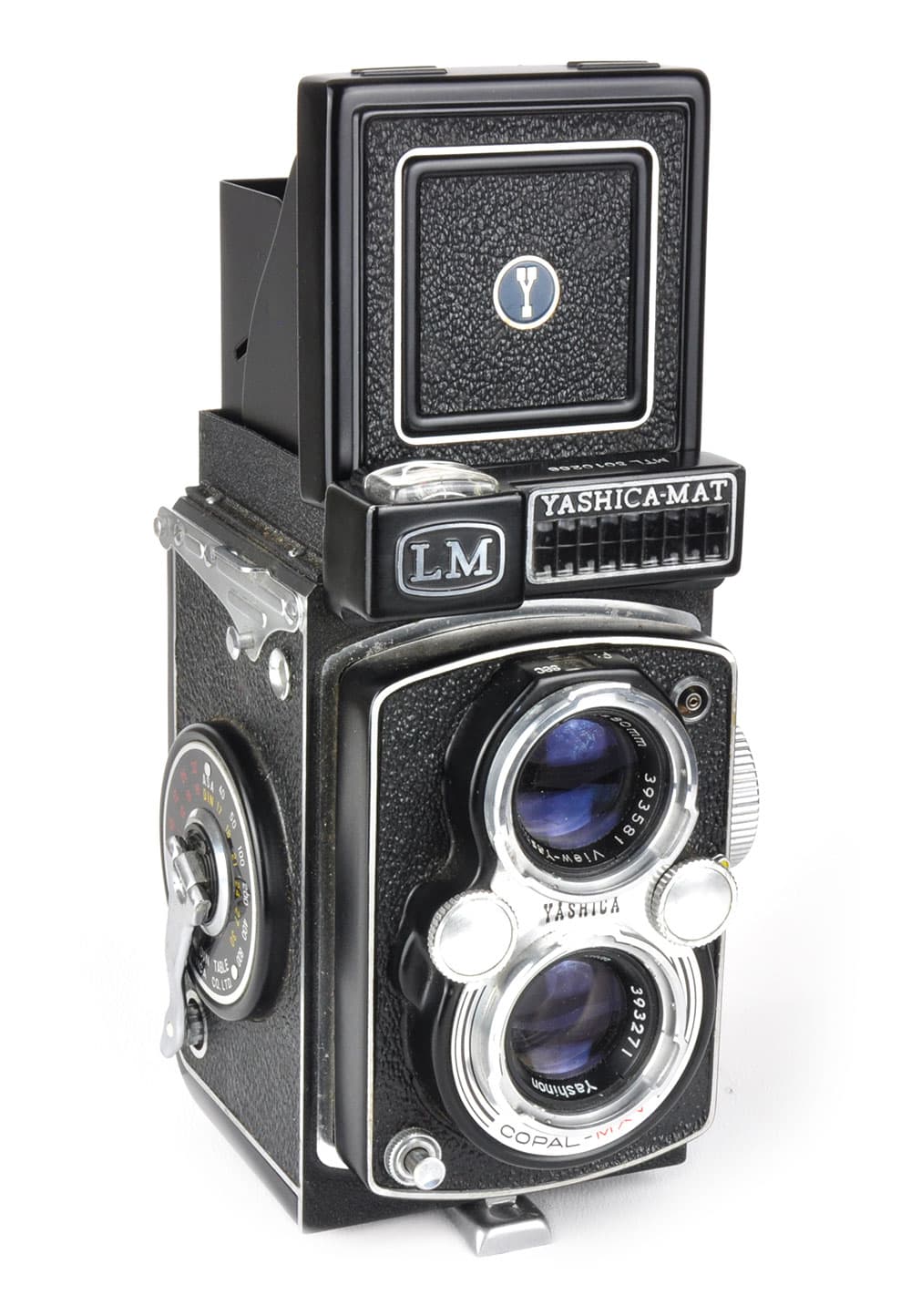
Yashica-Mat LM, medium format camera at an affordable price
Yashica-Mat LM
- Type Medium format TLR
- Launched 1958
- Original price £30
- Guide price now £50-70
When TLRs were the cameras of choice for professionals, everyone aspired to own a German Rolleiflex. If you couldn’t afford one, the next best thing was a Japanese Yashica-Mat. The LM model has a built-in meter which activates a needle across a scale numbered 0 to 10. The number indicated is set on a rotating dial built into the focusing knob to give a suggested aperture from f/3.5-f/22 against a shutter speeded 1-1/500sec. The combination is then set manually using small controls. The format is 6x6cm.
WE SAY Yashica-Mats were quality cameras when new, and remain so second-hand.
Cheap but usable
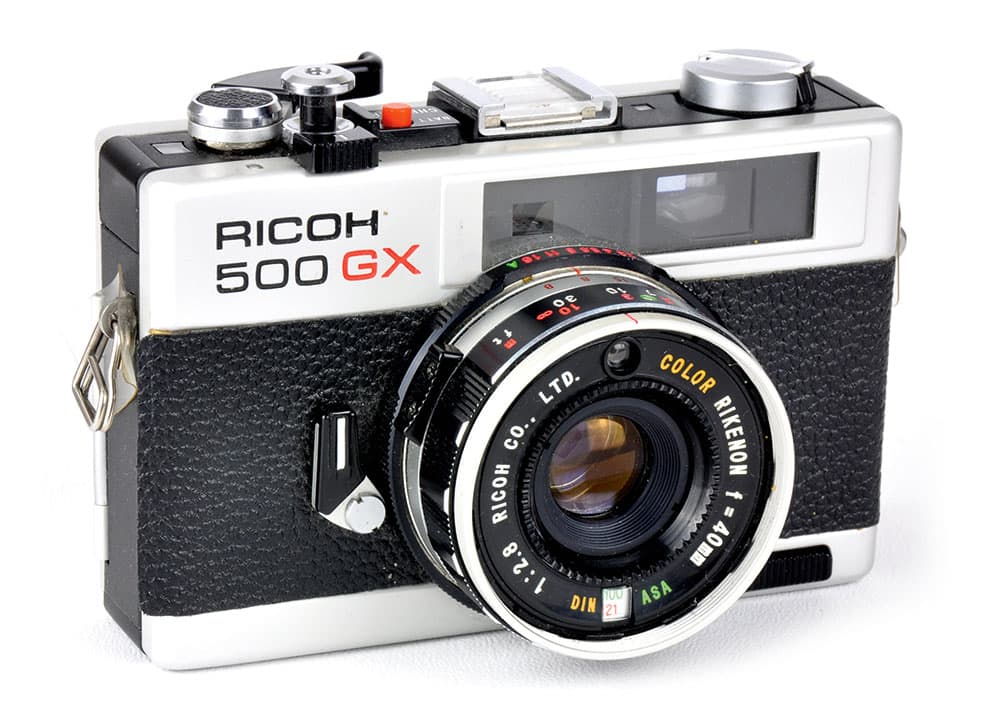
Ricoh 500GX, a well specified compact 35mm rangefinder camera
Ricoh 500GX
- Type 35mm rangefinder camera
- Launched 1976
- Original price £45
- Guide price now £25-30
Ricoh was always good at taking a different look at cameras of its era, and the 500GX is no exception.
Unusual for a camera of the 1970s, it has a coincident image rangefinder in the viewfinder. Shutter speeds of 1/8-1/500sec and apertures of f/2.8-f/16 can be set manually. But turn the aperture ring to its ‘A’ setting and the 500GX becomes a shutter priority camera.
A battery check button, delayed action and even a multi-exposure facility complete a well specified little camera.
WE SAY A quality camera with some interesting features, at a great price.
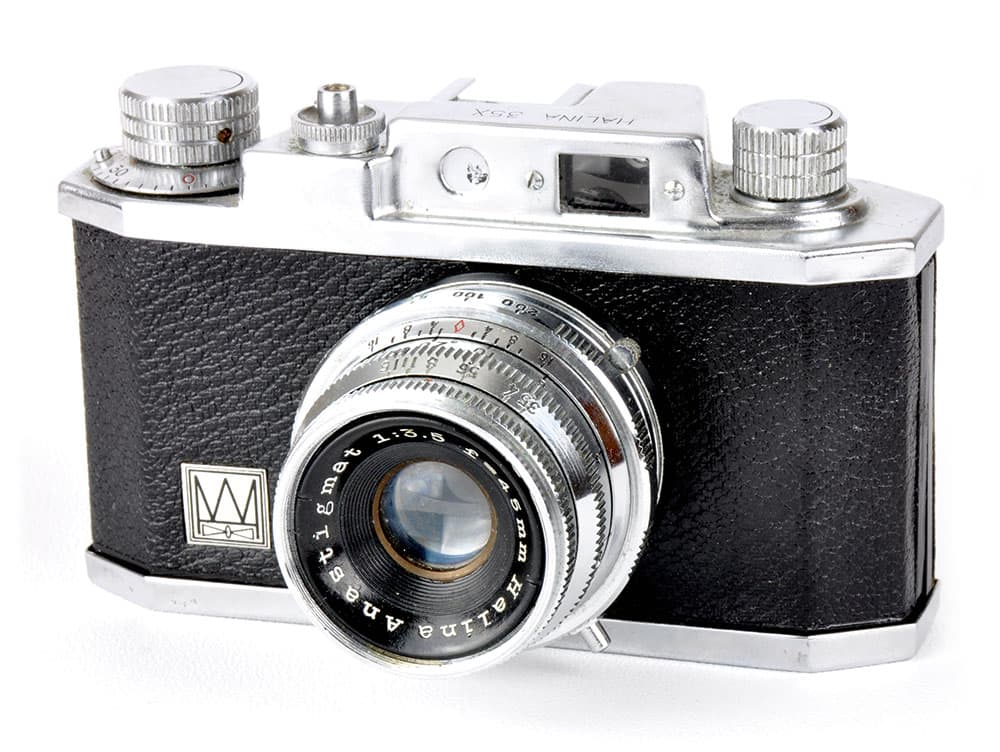
Halina 35X, cheap but still worth considering
Halina 35X
- Type 35mm viewfinder camera
- Launched 1959
- Original price £8
- Guide price now £5-10
Second-hand Halinas are freely available and remarkably cheap. With an all-metal body styled like a miniature Leica, the 45mm f/3.5 Halina Anastigmat lens performs well. The admittedly limited range of shutter speeds (they’re 1/25- 1/200sec) can usually be relied upon to have remained accurate.
There are two foibles to watch for. First, the aperture rings are always stiff, and it’s easy to inadvertently shift the focus while adjusting the aperture. Second, before exposure, the shutter must be tensioned with a lever beside the lens. Failure to do this means the shutter won’t fire, even though the interlock with the film wind is released, and the film must now be advanced without a picture having been taken.
WE SAY The Halina 35X gives great performance for not a lot of money.
Second-hand film cameras continued…
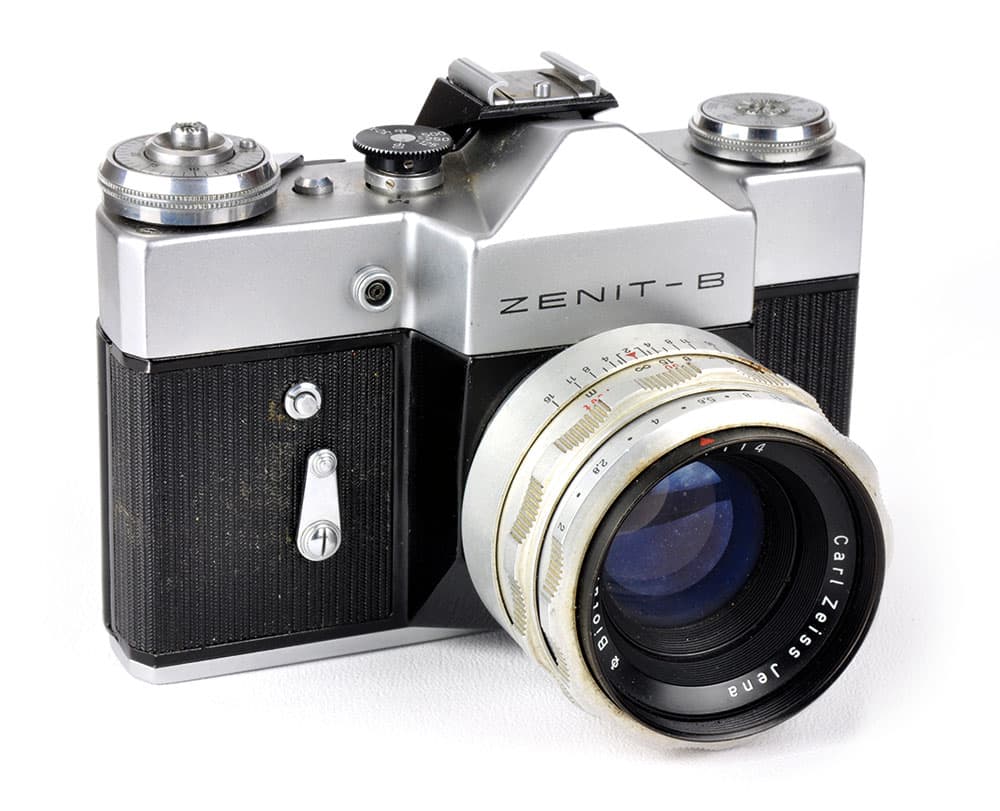
The Zenit-B fitted with an M42 mount 58mm f/2.8 Biotar lens
Zenit-B
- Type 35mm SLR
- Launched 1968
- Original price £41
- Guide price now £10-20
The M42 lens mount was one of the most popular of the past and there is still a vast amount of the lenses on the second-hand market. So, for an
inexpensive but basic 35mm SLR, it makes sense to invest in a body with an M42 mount. Pentaxes, Prakticas and Zenits are among the most popular.
The Zenit-B has everything you want and nothing you don’t. The focal plane shutter offers speeds of 1/30-1/500sec but there is no automatic diaphragm, which means the lens has to be manually opened to its widest aperture for focusing and stopped down to its taking aperture for shooting. There is no rangefinder to aid focusing, either.
WE SAY The Zenit-B isn’t exactly sophisticated but if you feel the urge to get right back to basics for the lowest possible outlay, this is the camera for you.
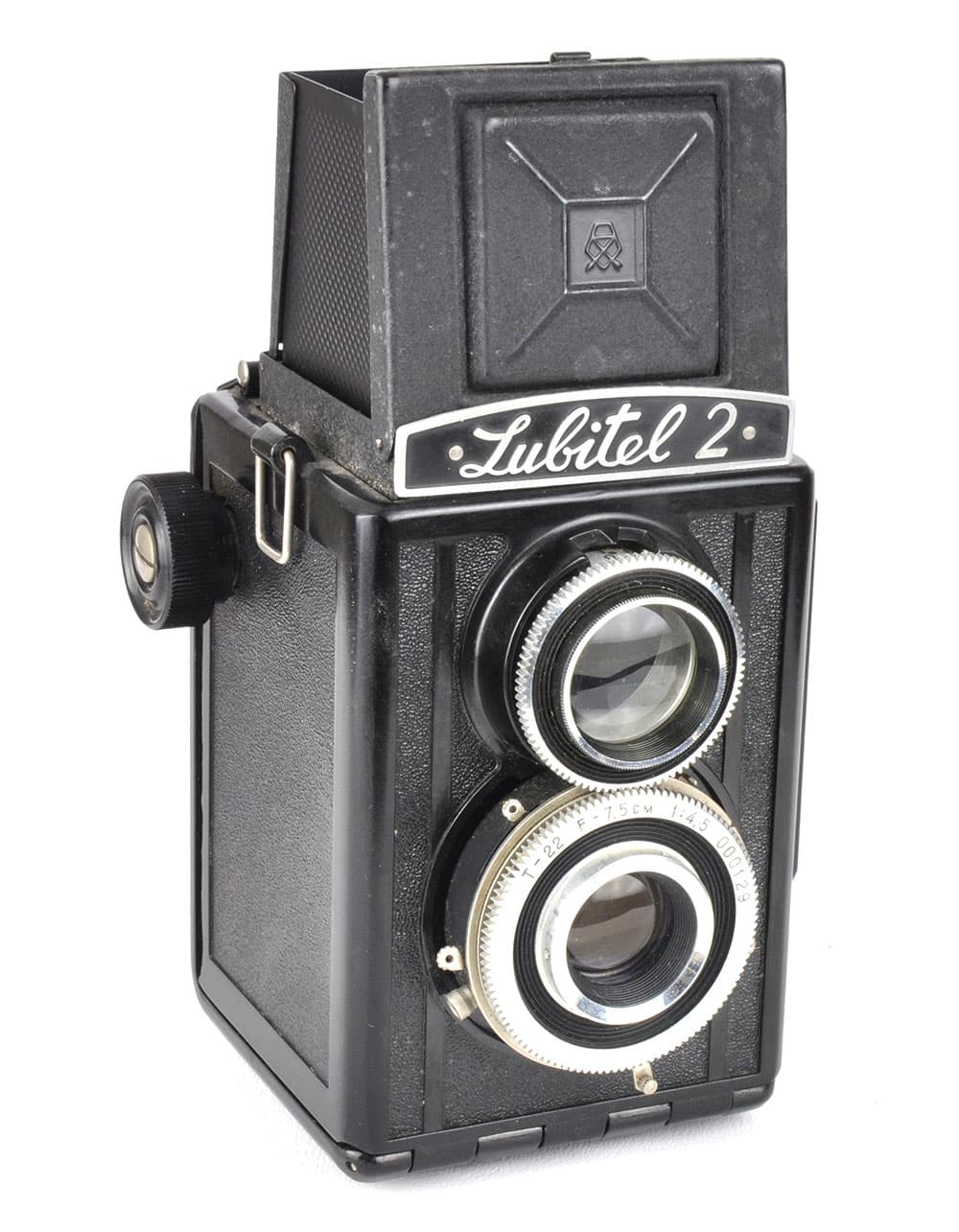
The Lubitel 2, an inexpensive copy of the Voigtländer Focusing Brillant
Lubitel 2
- Type Medium format TLR
- Launched 1955
- Original price £8
- Guide price now £15-20
Post-war Russian camera manufacturers were good at copying pre-war German cameras, and this one is a copy of the Voigtländer Focusing Brillant made in 1938. The format is 6x6cm.
The Lubitel 2 is a very simple TLR with the shooting lens linked to the viewing lens by cogs around both, which ensure they turn and focus at the same time. A useful range of shutter speeds of 1/15-1/250sec and apertures of f/4.5-f/22 are adjusted on scales beside the shooting lens.
What sets the Lubitel 2 apart from other cheap TLRs is its focusing screen, which takes the form of a large glass lens, rather than traditional ground glass. The result is a brighter than usual image, which photographers will find especially useful in low light conditions.
WE SAY The Lubitel 2 is an interesting camera with some unique qualities at a budget price.
Six things to check when buying a film camera…
Avoid buying a dud with our quick guide:
- Do the shutter speeds sound accurate?
- Do the focusing and aperture controls turn smoothly?
- Is the meter accurate?
- Does the rangefinder focus at infinity?
- Are there scratches, signs of fungus or cloudy elements in the lens?
- If the camera has bellows, are they light tight?
Where to buy
- From dealers to websites, there’s no shortage of places to buy your bargain camera…
- Second-hand camera dealers: check out the adverts at the back of AP
- Camera fairs: You’ll be able to find a list online for your area
- Auctions: Lots of options at www.the-saleroom.com
- Online: www.ebay.co.uk>Cameras & Photography
More great guides to buying a film camera:

